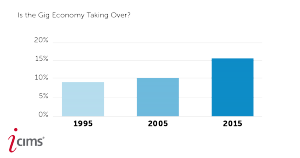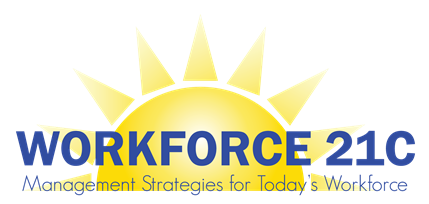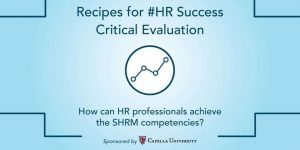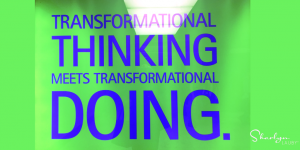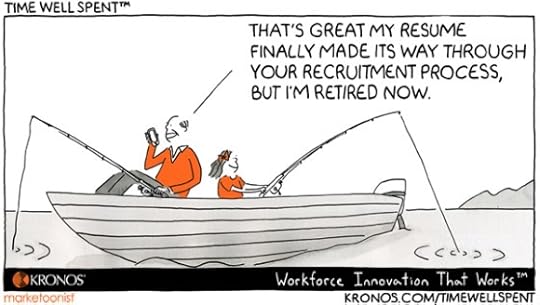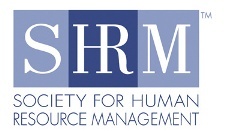Sharlyn J. Lauby's Blog, page 152
August 18, 2016
Is the Gig Economy Taking Over?
There’s an interesting dynamic in today’s workforce. It’s the proliferation of the gig economy, which is an environment where temporary positions (such as freelancers, contractors, and consultants) are common. There are advantages to this approach, the biggest being that organizations can tap into specialized talent when they need it. The challenge is that organizations need to engage temporary talent if they expect to keep them.
In iCIMS’ Q1 2016 U.S. Hiring Trends Report (PDF), they talk about the increase in contingent workers and its impact on overall hiring trends. It’s predicted that by 2020, 40 percent of U.S. workers will fall into the freelancer category (whether that’s on a full-time or part-time basis.)
Some industries are already accustomed to working with contingent staffing. I know from my days in the hospitality industry, we always had seasonal and on-call employees to help manage peaks and valleys in the operation. But I think there’s a bigger picture that organizations need to focus on.
The report mentions research from Lawrence Katz and Alan Krueger which argues that the growth of the gig economy is in part from “jobs” that we don’t typically think of as jobs. Probably the best way to describe it is that the gig economy is about tasks. This puts some pressure on HR and organizations to get job design right. Effectively using the gig economy means giving the right work to the right individual.
Is the Gig Economy Taking Over?
Click To Tweet
There’s also a challenge for employees. They have to gain the knowledge, skills, abilities and infrastructure to be successful freelancers. There’s more to being a successful freelancer than just knowing your craft. As a consultant, I have to think about marketing, budgeting, finance, office supplies and equipment, and my own development. The plus side is I can control those things. The downside is that they can drain resources in terms of time and money.
Organizations have to take both a strategic and long-term approach when it comes to their talent strategy. Employees need to take a long-term and strategic approach to their career strategy. That’s how people become (and stay) employed and companies get things done.
Image courtesy of the iCIMS Q1 2016 U.S. Hiring Trends Report
The post Is the Gig Economy Taking Over? appeared first on hr bartender.






August 16, 2016
Use Gumby to Keep Employees Focused on Goals
Remember Gumby? He’s a green clay animation figure created by Al Clokey in the early 1950s who went on adventures with his sidekick, Pokey, an orange talking pony. Gumby has been featured on television, in movies, and even parodied by Eddie Murphy on Saturday Night Live.
During this year’s Great Place to Work conference, I learned that Gumby has also been used as a business icon. Sharon Price John, CEO of Build-A-Bear Workshop, shared her company’s turnaround story. As part of the discussion, she talked about how tempting it can be for organization’s to fall back into old habits once the crisis is over.
I’ve seen this many times. The most common example is the person who finds themselves without a job. They realize how little networking they’ve done over the years and swear that they’ve learned their lesson. Networking will now be a priority. Then the person finds a job and what do they do? Exactly. They stop networking.
But, back to the Build-A-Bear story. Once the company returned to profitability, to keep the employees focused on goals, Gumby became a reminder of the things that needed to be done:
Stay flexible
Keep all the parts moving together (meaning keep working as a team)
Remain positive
STRETCH to hit goals
Focus on the green (aka money)
I really love this. It’s fun and easy to remember. In the Build-A-Bear story, they bought a Gumby suit and had someone dress up as Gumby for employee events. But anyone can use Gumby as a way to stay focused on goals. I bought a Gumby on Amazon. It’s on my desk. You can probably find Gumby stickers. The point is, find a way for employees to stay on track. Even if it’s using a green animation figurine.
Change is hard. Especially in situations like Build-A-Bear where they needed to make change or risk losing the business. But that doesn’t mean there can’t be moments of simple fun that serves a business purpose. In fact, one could argue that those moments of fun are part of the reason that the organization can manage change successfully – because they know how to make it work … and make it fun.
P.S. I really enjoy sharing with you my takeaways from the Great Place to Work Conference. Which is why I’m super excited to be attending the 2016 Great Place to Work® Small & Medium Business Conference in Austin! We know that investing in your people leads to strengthened recruitment, retention and overall profitability. It’s sure to be a terrific event. Readers of HR Bartender can receive $100 off registration using the code SMBAUSTIN16. Look forward to seeing you there!
Image taken by Sharlyn Lauby somewhere at HR Bartender Central.
The post Use Gumby to Keep Employees Focused on Goals appeared first on hr bartender.






August 14, 2016
Organizations Need to Consider Family Caregiver Responsibilities
During this year’s Society for Human Resource Management (SHRM) Annual Conference, I had the opportunity to attend a luncheon hosted by the SHRM Foundation. I consider the Foundation to be one of SHRM’s best kept secrets. Their mission is human resources research and education.
At the luncheon, we were given a report co-sponsored by AARP and ReACT, titled “Determining the Return on Investment: Supportive Policies for Employee Caregivers”(PDF). It’s a good read and worth your time. It also made me realize that I haven’t written much about caregiving.
So I asked Cynthia Thomas Calvert if she would share her knowledge with us, and luckily she said “yes.” She’s a nationally-recognized lawyer, researcher, speaker, and president of Workforce 21C. Through training and consulting, she helps employers manage issues related to family responsibilities, reducing unconscious bias, and creating inclusive workplace cultures. She recently authored a report about caregiver discrimination (PDF) for the Center for WorkLife Law.
And because Cynthia is a lawyer, I want to remind everyone that her comments should not be construed as legal advice or as pertaining to any specific factual situations. If you have specific, detailed questions, you should address them directly with your friendly labor attorney.
Cynthia, let’s start with a definition. When I first heard the term caregiving, it was in the context of taking care of a parent or older family member. But I’m under the impression that it means so much more today. What’s caregiving?
 [Cynthia] ‘Caregiving,’ as we use it, refers to providing care to family members, so it includes caring for young children, sick spouses, adult children or spouses who have disabilities, and aging, sick, or disabled parents. It also includes being pregnant, and taking care of or bonding with newborns and newly adopted children. We use ‘caregiver discrimination’ and ‘family responsibilities discrimination’ (FRD) interchangeably.
[Cynthia] ‘Caregiving,’ as we use it, refers to providing care to family members, so it includes caring for young children, sick spouses, adult children or spouses who have disabilities, and aging, sick, or disabled parents. It also includes being pregnant, and taking care of or bonding with newborns and newly adopted children. We use ‘caregiver discrimination’ and ‘family responsibilities discrimination’ (FRD) interchangeably.
We’re starting to see more attention being given to the topic of caregiving. What are 2-3 trends in the area of caregiving that companies should pay attention to?
[Cynthia] The first trend, and this is really key, is that the number of caregivers is growing very quickly. The number of seniors who need care is increasing rapidly and expected to continue to increase significantly in the coming decades (in fact, in a survey, half of all employees said they expect to provide elder care within the next five years), and some chronic diseases and disabilities are on the rise (such as diabetes, dementia, and autism). In addition, more pregnant women are working and are working later into their pregnancies. As a result, it is fair to say that almost every employee will be a caregiver at some point during his or her career.
Closely related to the first trend is the trend of more males providing care. Males now provide more than 40 percent of elder care, and more males are actively involved in providing child and spousal care.
Another trend is new legislation on the state and local level that requires employers to provide accommodations to pregnant women and employees who are nursing, and to allow employees to take sick leave – without retaliation – to care for family members. Several states and many local jurisdictions also now have laws that expressly prohibit family responsibilities discrimination in employment, and a couple even require employers to consider requests for flexible work.
You mentioned accommodations. Is caregiving covered under the law (i.e. meaning organizations cannot discriminate based on a person’s status as a caregiver?)
[Cynthia] Yes and no. Almost 100 jurisdictions – including New York, Minnesota, the District of Columbia, New York City, Boston, Chicago, San Francisco, Philadelphia, Pittsburgh, and Miami – have laws that expressly prohibit employment discrimination based on family responsibilities, family status, or caregiver status.
In addition, the Americans with Disabilities Act (ADA) prohibits discrimination based on an employee’s association (including caregiving) with an individual who has a disability. But there is no federal law that expressly prohibits caregiver discrimination. In jurisdictions without an FRD law, employees who provide family care may be protected from discrimination by sex and pregnancy discrimination laws and family and medical leave laws. If a law does not apply in a particular situation, an employee might sue for wrongful discharge, breach of contract, infliction of emotional distress, and the like.
Many employers are not aware that discrimination based on caregiving can be illegal, and they find out the hard way when they are called into court or investigated by a government agency.
Given the legislative trend, should organizations consider developing caregiver policies? Why or why not?
[Cynthia] Management lawyers are of two minds on the issue of whether to have an anti-discrimination policy that prohibits caregiver discrimination. On the one hand, if the employer is in a jurisdiction that does not expressly prohibit caregiver discrimination, a policy could arguably give rise to claims that an employer otherwise might not face or encourage employees to bring lawsuits.
On the other hand, employers may be able to limit damages and avoid punitive damages if they can show that they actively worked to prevent family responsibilities discrimination by having a policy, training HR and personnel about FRD prevention, and responded promptly and appropriately to complaints of FRD.
Over time, it seems that more lawyers have shifted to the side of recommending that their clients take steps to prevent FRD because it can negatively affect a company even if the company is not sued.
Are there steps employers can take beyond writing a policy?
[Cynthia] There are plenty of other steps employers can take to prevent FRD, aside from implementing an anti-discrimination policy. One is to train supervisors and HR on what FRD is and how and why it commonly arises:
Unconscious biases often affect how supervisors perceive employees and their work, what assignments and opportunities are given to employees, and how employees are disciplined.
We all have biases about caregivers – some common ones are that mothers will prioritize family over work and not be committed to their jobs, and that men who actively provide care are not masculine, ambitious, or dependable.
Supervisors might pass over mothers for challenging assignments or deny them promotions based on ‘gut feelings’ that they would not be a good fit – which is a key way that bias influences personnel decisions.
Similarly, supervisors may try to talk men out of taking leave, thinking that they are helping the men to preserve their standing in the company, or may punish them with undesirable work or difficult schedules to make sure they (and other men) think twice before providing care in the future.
This is why training is important. These supervisors don’t think they are discriminating. In fact, most would probably tell you that they are doing what is best for the company by making sure that the best employees get ahead and that everyone works hard. The problem is that these kinds of actions can create severe stress for the employees involved, which can prevent them from performing well, and can damage the morale and productivity of their co-workers as they watch what is happening and wonder if it will happen to them as well. The caregivers may quit or be fired, and their co-workers may start looking for a better employer.
So, although the supervisors were well intentioned, they may have caused expensive attrition, loss of institutional knowledge, damage to productivity, and harm to corporate reputations. And then if the caregivers sue, a new can of worms is opened.
Training alone can’t solve FRD, of course. There are many other steps that HR can take to watch out for, prevent, and remedy FRD. Some involve policies and practices, some involve knowing triggers of FRD and providing oversight in situations where it is likely to crop up, others involve having an investigation protocol that includes FRD, and still others involve addressing the biases that cause FRD.
If my organization implements a caregiver policy and manager training, what kinds of benefits can we expect?
[Cynthia] Given that so many employees are or will be caregivers, employers who adjust to this reality can expect to become the desirable employers. Companies that earn reputations for working to prevent discrimination against caregivers and that offer programs to make it easier for employees to provide care while still continuing to work will attract more applicants and improve retention of good employees – both of which can translate to better service and lower costs. They can also expect more loyal employees who are engaged and productive, and who become brand ambassadors. And, of course, they can expect to avoid a lot of litigation expenses!
My thanks to Cynthia for sharing her knowledge and experience with us. We have a tendency to talk about illnesses and health care from an insurance perspective or a leave point of view. Organizations will need to realize the growing need to think about caregivers. An increasing number of employees are facing this situation and need our support.
Image taken by Sharlyn Lauby (psst . . . it was a wedding gift)
The post Organizations Need to Consider Family Caregiver Responsibilities appeared first on hr bartender.






August 12, 2016
Recipes for #HR Success: Critical Evaluation
(Editor’s Note: This series is brought to you by our friends at Capella University. Capella is an accredited online university dedicated to providing an exceptional, professionally aligned education that puts you in the best position to succeed in your field. Enjoy the post!)
A few weeks ago, I wrote about a Harvard Business Review article titled, “The Changing Role of the CHRO.” The article talks about the need for HR professionals to develop analytical skills. And I totally agree, analytical skills are important. There are many times when we must use analysis or logical reasoning.
But analytical skills are only one facet of critical evaluation. By definition, critical evaluation is “the process of actively and skillfully conceptualizing, applying, analyzing, synthesizing, and evaluating information to reach an answer or conclusion.” It seems to me the key difference is the “to reach an answer or conclusion” part. Critical evaluation encompasses both thinking and action.
Even if the action is to wait, monitor, or do nothing at all. That decision is action. It was based on critical evaluation.
One of the things I like about critical evaluation is that there’s no one method. For example, you can use the Socratic method, which is grounded in hypothesis elimination. Another approach if you like hypothesis is the Scientific Method.
While Lewin’s Force Field Analysis is considered a decision making technique, I can see it being used for critical evaluation. It allows you to evaluate the forces for and against a change to reach a decision. As such, it also helps when it’s time to communicate that decision.
The important piece to critical evaluation is to find a method that works for you. You’ve probably noticed that here on HR Bartender I often resort to the dictionary to help me evaluate concepts.
The other essential action in critical evaluation is getting comfortable with saying, “I don’t know.”
Sometimes we’ll need another point of view in order to reach an answer or conclusion. Maybe we’ll need more time to consider the information. And sometimes, we’ll never get all of the information we want.
As human resources professionals, we need to be ready to evaluate data and information to make good decisions for the business. We also need to call upon the expertise of our colleagues when we’re stumped. It’s not a sign of weakness; it’s a sign of smartness and strength. Because you will learn from the opportunity.
The post Recipes for #HR Success: Critical Evaluation appeared first on hr bartender.






August 11, 2016
Corporate Training: You Can Learn Anything
“You only have to know one thing. You can learn anything.”
That was the takeaway message from Salman Khan, founder of the Khan Academy. Khan was the closing keynote speaker at this year’s Society for Human Resource Management (SHRM) Annual Conference and Expo in Washington D.C. His presentation told the story of the Khan Academy, which you can see in his TED talk.
But in telling the Khan Academy story, he talked about the future of learning. While many of his comments were in the context of education, some of the concepts he mentions are popular and valuable components of the corporate learning environment.
Flipping the classroom. In traditional education, students learn the lesson/model/theory in the classroom. Homework is the activity that supports the lesson. The Khan Academy encourages students to listen to the lesson outside of the classroom (i.e., prework) then do the activities in the classroom.
Mastery-based learning. Dan Pink in his book “Drive: The Surprising Truth About What Motivates Us” says the secret to high performance and employee satisfaction is three things: purpose, mastery, and autonomy. When it comes to skill mastery, the Khan Academy encourages people to practice and experiment with skill learning until they master them.
It got me thinking. From a corporate learning perspective, where’s the Khan Academy of business? Are organizations putting together books, videos, etc. so employees can become lifelong learners? Do employees have time on their schedule just to learn? If we want employees to succeed, they have to be able to learn anything.
In my home state, the workforce agency is asking public schools to include employability skills in their curriculums such as interviewing, communication, teamwork, time management, listening, and networking. A workforce agency representative is quoted as saying, “these are skills that people would need to succeed in any employment situation.” True. Very true. It raises the question, “Where are these skills being learned now?”
I mention what’s happening in my state because it’s an example of a learning gap. We want employees to be successful because, when they are, the organization is successful. But that means organizations have to create a learning culture so they can spend time mastering the skills they need.
The post Corporate Training: You Can Learn Anything appeared first on hr bartender.






August 9, 2016
Why Your Organization Should Consider an Internal Hackathon
Last year, I interviewed Steve Boese, co-chair of the HR Technology Conference, on the topic of hackathons. A hackathon is an event during which participants collaborate, conceptualize and test new products or services. The event is usually followed with a presentation to a panel of decision makers.
When this event is done externally, the hackathon might be considered a competition of sorts, with the presentation being to a group of judges. However, hackathons can be done internally too. Facebook is known for having employee hackathons and LinkedIn held a non-technical hackathon last year.
The reason I wanted to bring up hackathons again is because I ran across a terrific guide from RallyTeam on “The Definitive Guide to Enterprise Hackathons.” The reason I liked it is because it paints a picture that any organization can hold a hackathon. It’s not a technology company thing. Or a startup thing.
In fact, while I was reading the guide, I was reminded of a company I worked for that did something conceptually similar. The management team was brought together to discuss the top challenges facing the organization. The topics were prioritized. Then the managers were placed into groups and asked to work on one of the problems. Our task was to research the topic, identify the challenges, and brainstorm viable solutions.
Then the teams met during an offsite meeting to present our issue and proposed solution. The group got to decide whether or not to move forward with our recommendation. It was like a hackathon that took place over a longer time frame.
But sometimes, having that longer time frame might be a disadvantage. Maybe having too much time to think about it leads to analysis paralysis and inaction. The hackathon environment might be exactly the adrenaline rush that the organization needs. Something to think about.
So if you’re organization is looking to jump start some new thinking, a hackathon might be the format to consider. The RallyTeam guide walks you through the process: from room logistics to marketing the event. And if you want to see a hackathon in action, the HR Technology Conference and Expo will be holding another hackathon event this year. The conference is October 4-7, 2016 in Chicago. HR Bartender readers can receive a $200 discount on registration using the code LAUBY16. Hope to see you there!
Image taken by Sharlyn Lauby after speaking at the HR Change & Transformation Conference in London, England
The post Why Your Organization Should Consider an Internal Hackathon appeared first on hr bartender.






August 7, 2016
Are Companies Obligated to Write Reference Letters – Ask #HR Bartender
I mentioned in my #SHRM16 wrap-up that I spoke at a pre-conference workshop on social media strategies. This question came up at the workshop and someone else asked it on HR Bartender just a few days ago. It’s obviously a popular topic.
If an employee’s current manager refuses to provide a letter of reference, even if employee is in good standing, is that an EEOC violation?
During the workshop, Jonathan Segal, a partner with the law firm Duane Morris LLP fielded the question, so I asked if he would help us here. And thankfully he said yes. Jonathan has helped us out before, most recently with the final ruling from the U.S. Department of Labor on the changes to the overtime rule in the Fair Labor Standards Act (FLSA.)
I know I don’t have to remind you, but just in case, please remember that Jonathan has a regular full-time job and he’s doing this as a way to give back to the profession. His comments should not be construed as legal advice or as pertaining to any specific factual situations. If you have detailed questions, you should address them directly with your friendly neighborhood labor attorney.
Jonathan, let’s make sure we’re on the same page with this topic. Are reference letters, recommendations, and endorsements considered the same thing? Why or why not? (HRB readers: You’ll see where we’re going with this in a moment.)
 [Segal] The label really does not matter. What matters is that you are communicating information about a current or former employee. A substantive letter of reference or affirmative recommendation has more business and legal significance than a ‘LinkedIn’ endorsement or the like. It has more business significance because there is content and for the same reason it has more legal significance.
[Segal] The label really does not matter. What matters is that you are communicating information about a current or former employee. A substantive letter of reference or affirmative recommendation has more business and legal significance than a ‘LinkedIn’ endorsement or the like. It has more business significance because there is content and for the same reason it has more legal significance.
But even an endorsement can have legal consequences. Here’s an example: Let’s assume you endorse an employee and then later fire him or her for poor performance. Or, worse yet, you endorse an employee after firing him or her for poor performance.
The former employee’s lawyer argues that the reason given for termination—poor performance—is pretext for unlawful discrimination. The inconsistency that supports the argument: the endorsement that does not jive with reason for termination.
Regardless of their performance, are companies or managers obligated to provide reference letters to employees?
[Segal] No, there is no law that makes it illegal to provide an evaluation, whether it be positive, negative or somewhere in between. Of course, what you say may have consequences. For example, giving a positive letter of reference when someone has engaged in misconduct may give rise to a misrepresentation claim if the employee engages in misconduct for the new employer.
But there are risks in not giving them, too. Every former employee is a potential business influencer in the future. Deny a worthy employee of a reference, when he or she is in a position of power with a customer or potential customer, he or she may remember that.
Many employers give only neutral references, simply confirming dates of employment and position held. If an employer wants to get substantive references from others, then they may need to provide substantive references themselves.
Managers need to make sure that they are permitted to give reference letters. Many employers require that only HR provide them. The manager may think I am doing this in my personal capacity. The plaintiffs’ law may think ‘personal liability.’
I’m glad you brought up employee reference policies. Many organizations have them. What should organizations remember when it comes to policies about employee reference letters?
[Segal] Here are a few things to keep in mind:
1. Establish who can give reference letters.
If only HR can give references, make sure supervisors (and above) know to report any reference requests for them to HR without comment.
Respond only to written or electronic requests for references and then confirm that the requesting party is who they say they are. Sadly, there are some individuals who seek to obtain references under false pretenses to manufacture a defamation claim. (Editor’s Comment: UGH!)
2. Have as your default position that you ‘ordinarily’ will provide neutral references only.
When giving a neutral reference, state expressly that it is your general policy to provide neutral references only. That makes it harder for someone to argue there is a negative implication in giving the neutral reference.
Note: the use of the word ‘general’ to qualify that policy reserves the right to give substantive references in exceptional cases without rubbing up.
3. In exceptional circumstances, you may want to provide a substantive reference, such as: outstandingly strong performance or employee misconduct. When giving substantive reference letters:
If positive, make clear you give substantive reference only when someone is exceptionally strong and this is one of those cases. This makes it hard for someone to argue that you defamed them by giving them only a neutral reference. It would be an up-hill battle to argue that not saying an employee is exceptionally strong is, by negative implication, defamation.
If giving a negative reference, focus on specific behaviors and avoid labels that can be attacked. For example, don’t say ‘Mark is dishonest.’ Say instead: ‘Mark did not disclose material information about a deal when asked.” Remember the truth is a defense to a defamation claim and behaviors are easier to prove than labels. Of course, only include behaviors you can prove.
4. Educate supervisors and above that endorsement or recommendation on LinkedIn or other social media is a reference
Speaking of social media, let’s talk about LinkedIn. The platform allows users to “endorse” and “recommend.” What should organizations and individuals understand before providing an endorsement or recommendation on social media?
[Segal] Don’t do it, unless you have approval from your organization. And, HR, approve sparingly. Let’s remember social media is very public. If you want to give a reference, I would consider another forum, such as an old fashion letter. Check Wikipedia for the definition of letter. Here’s why:
Jane gets a neutral reference and accepts it. Then, she sees that Tom got a glowing recommendation on LinkedIn. He deserved it and Jane did not but now it is in Jane’s face. She might allege gender, age, race or other bias, depending on both of their EEO demographics. We can give reference but we need to be savvy on how we do so. Not everything needs to be on social media.
Okay, so forget endorsements/recommendations for a moment. In today’s world of social media, can connecting with someone, liking their postings, or sharing their updates be considered a recommendation or endorsement?
[Segal] Great question. Probably not. But it is better when dealing with a current or former employee to focus on the content and not the person. There is a big difference between ‘great information’ versus ‘wise person.’
Also, include on your Twitter handle something like: Tweet or Retweet does not equal endorsement. It is not a ‘get out of court’ card but helpful. There are other ways to deal with issues on other social media platforms.
If you’re not a current or former employee, there is much less risk in praising an individual. But do so only honestly. Your own credibility suffers if you are not selective in your praise.
My thanks to Jonathan for sharing his knowledge with us. Be sure to follow him on Twitter @Jonathan_HR_Law or read his blog at Duane Morris. I believe Jonathan is spot on with his comment about personal credibility in providing employee reference letters. Not only do individuals need to know their company policy but they should establish their own personal guidelines when it comes to providing references.
Image taken by Sharlyn Lauby after speaking at the Healthcare Human Resources Association Conference in Stillwater, MN
The post Are Companies Obligated to Write Reference Letters – Ask #HR Bartender appeared first on hr bartender.






August 5, 2016
Recruitment Must Be Both Good and Fast – Friday Distraction
(Editor’s Note: Today’s post is brought to you by our friends at Kronos, the global leader in delivering workforce management solutions in the cloud. Kronos CEO Aron Ain was recently . We’ve been honored to interview Aron on building a world-class company culture. Congrats to him and enjoy the post!)
The Society for Human Resource Management (SHRM) recently published an article talking about quality of hire being the top metric for human resources. I agree that quality of hire is important. Unfortunately, it’s also a very difficult metric to calculate. If you aren’t calculating any metrics or just starting to calculate some, quality of hire might not be the place to start. Get the organization accustomed to metrics first. Then, introduce the more complex ones.
In the meantime, consider focusing on speed. A common metric to measure is time to fill or time to start. Organizations can attract the best talent, but if the recruitment process takes a long time…well, things like this might happen.
This Time Well Spent cartoon from our friends at Kronos reminds me that we need to balance our recruitment efforts like a three-legged stool. We want quality candidates, in a timely fashion, within a reasonable cost. It’s the concept of good, fast, or cheap.
If we hire the best candidates quickly, does that increase our cost to hire?
If we extend offers to the first candidate who has below-market compensation requirements, are we getting the best?
If we’re willing to pay top dollar for the best talent, how long will it take for us to find them?
Ideally, our recruitment process should balance all three components – quality, cost, and time. It’s possible that the way a company ranks these factors might impact whether they hire a full-time employee or a freelancer.
Bottom-line: everyone involved in the recruitment process needs to understand the company’s hiring priorities. Otherwise, they’re working at cross purposes. One person may be working to save costs while another is trying to speed the process.
Do you know which one your company values most – candidate quality, time to start, or cost per hire?
The post Recruitment Must Be Both Good and Fast – Friday Distraction appeared first on hr bartender.






August 4, 2016
Tell Your Company’s Succession Planning Story
It’s a common assumption that most organizations don’t do succession planning. IMHO, the reasons include the high level of administration involved with succession planning and the difficulty in identifying and developing talent. It’s hard enough to figure out what the business world will look like in three years, much less what the organization’s talent needs will be.
However, succession planning is still important. So when the Society for Human Resource Management (SHRM) asked me to participate in their succession planning seminar, I jumped at the opportunity.
Before I share with you a couple of takeaways from the seminar, I want to talk a little about the seminar itself. I had never participated in a regularly scheduled virtual program before, so it was a new experience. The program instructor, Mike Deblieux SHRM-SCP, was visible via webcam but the participants were not. We would communicate via chat. As an introvert, I really liked the format. I could be an active part of the chat when I wanted to. I could also sit back and take in the conversation. So for those of you who are more reflective during learning, this could be a great option. The session is also offered as an in-person program for individuals who prefer that experience.
Okay, back to takeaways. I don’t want to give away the entire seminar but the big takeaway for me was the concept of telling your succession planning story. Organizations put a tremendous emphasis on their branding story, product/services story, or their vision for the company story. But what about their succession planning story?
Forget for a second the whole “do we or don’t we tell a candidate they’re a part of the plan” conversation. If we think about what’s involved in succession planning, there’s still plenty to tell in your story.
How does the organization decide what the critical jobs are?
What method does the organization use to identify talent?
What’s the company philosophy about investing in talent?
The answers to these questions create a story that employees and candidates want to know. The company’s succession planning story makes the process future-focused. During the seminar, Mike gave us a recommended activity that we could use to jump start our creative process and gain a new perspective where succession planning was concerned.
Every three to five years, pack up your office on a Friday. Come in as a new manager on Monday. Rearrange your furniture. Put away your stuff. Get a little uncomfortable. Experience what it feels like to be a new manager within your organization.
Maybe if we remember what it feels like to be a new manager – unpacking things, trying to get settled in, figuring out a work environment that will make us productive – it will help us craft that succession planning story.
And it will help us keep the company’s succession planning story alive. During the seminar, one of the participants talked about using post-it notes as a way to discuss talent readiness in succession planning. I thought it was terrific symbolism. An employee can be added, removed or moved in the succession plan as simply as adding, removing or moving a post-it from one document to another.
Organizations need to tell candidates and employees their succession planning story
Click To Tweet
Our succession plans should be fluid documents and our succession planning story should be as well. It should be a story that aligns with the company strategy and brand. As those things change, so will the story.
Maybe the reason that companies don’t do succession planning is because they just haven’t figured out their story. Because once you have the story, then the planning part falls into place.
P.S. I would absolutely recommend taking SHRM’s succession planning seminar. The seminar is offered virtually and in several cities around the U.S. You can find a complete listing of seminars, dates, times, and locations on the SHRM Education website. Also, remember that SHRM seminars are pre-approved for recertification credit.
Society for Human Resource Management (SHRM) logo used with permission.
Image captured by Sharlyn Lauby after speaking at the Flora Icelandic HR Management Conference in Reykjavik, Iceland
The post Tell Your Company’s Succession Planning Story appeared first on hr bartender.






August 2, 2016
Professional Ghosting: Is It the New “No”
I’ve seen a new term lately called “ghosting.” The Urban Dictionary defines it as “the act of suddenly ceasing all communication with someone.” It’s done in the hopes that the person being ghosted will come to the realization on their own that the other person wants nothing to do with them and they’ll just go away. The idea being that the person doing the ghosting is avoiding a difficult conversation or hurting another person’s feelings by ignoring them.
The Urban Dictionary also seems to imply that ghosting is related to a person’s level of maturity and communication skills (and not in a positive way.)
Ghosting has been typically associated with dating and friendships, but after reading a post on GOOD titled, “Just Checking In…Again,” I’m wondering if there’s such a thing as professional or business ghosting?
You can read the article yourself, but basically it’s about applying for a job and never receiving a response from the company. As readers of this blog, you know I’ve received several letters from readers about the exact same thing. Candidates who are upset because the organization won’t tell them what’s going on. While candidates never want a TBNT letter (thanks but no thanks,) at least the letter brings closure.
But not hearing about the status of your job application isn’t the only form of professional ghosting. Ever submitted a proposal to your boss or a prospective client never to hear any feedback? What about the person you meet at a networking event who asks you to follow-up with them in the office only to never take your call?
One thing to note about ghosting is that it’s predicated on an interaction or relationship. If someone doesn’t get a reply to a cold call or a blind pitch, that’s not ghosting. There’s an implied expectation or response element to ghosting that doesn’t exist with other one-way communications. Ghosting is a response in two-way communication.
The more I think about it, the more I can see that professional ghosting exists. The question becomes “why?”
On one hand, I can see a person rationalizing that ghosting is a way to let someone down softly without hurting their feelings. Although personally, I want to call bravo sierra on that reasoning. It is possible to tell someone “no” in such a way that they can ultimately benefit from it. If you want to learn more about how to do it, check out “The Power of a Positive No” by William Ury.
Another reason that I’ve seen quite a bit (especially with consultants) is the person who views everyone as their potential customer so they say whatever that person wants to hear. They never disagree with anything anyone has to say. Sometimes this approach of always saying “yes” can build to a point where the individual just has to remove themselves from interactions. So instead of respectfully disagreeing, a person resorts to ghosting. Again, it’s important to remember that everyone is not your customer and all conversations do not have to be delivered with radical candor.
The way I see it, ghosting can send the message that a person doesn’t care or value the relationship enough to even say “no.” If that’s the message the individual wants to send, then ghosting is an option. However, ghosting to simply avoid saying, “I can’t support that idea right now.” or “I think the proposal needs more work in this area.” Isn’t helpful to anyone. And could actually do some harm.
However, the thing that really scares me about ghosting is that it might be possible to create ghosting cultures. Can you imagine organizations where ghosting is how employees communicate (or not communicate) with each other? What impact does that have on the organization’s ability to develop and execute strategy, communicate with customers, and engage employees? As a human resources professional, how do we stop ghosting from becoming acceptable behavior?
Image taken by Sharlyn Lauby on Día de Muertos somewhere off the coast of Mexico
The post Professional Ghosting: Is It the New “No” appeared first on hr bartender.






Sharlyn J. Lauby's Blog
- Sharlyn J. Lauby's profile
- 10 followers


